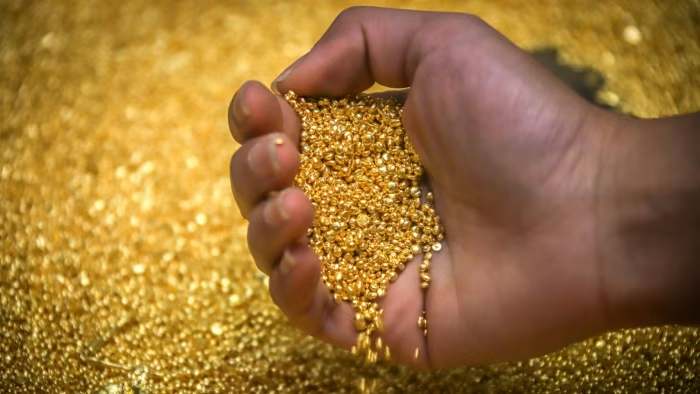Multiple positives boost gold's "surging" momentum, with a potential challenge to $3,000 by 2025
There are many reasons for the rise in gold prices.
Gold Continues Its Record-Breaking Surge
On August 20th, gold prices continued their record-breaking climb, holding firmly above the key level of $2,500 per ounce. Spot gold rose by 0.3% for the day, closing at $2,510.35 per ounce, and earlier in the session, it set a new historical high of $2,531.60 per ounce. This surge in price is attributed to the weakening of the US dollar and the market's increased expectations that the Federal Reserve may cut interest rates in September.
There are many reasons behind the rise in gold prices.
On one hand, the continuous weakening of the US dollar, especially with the US Dollar Index falling to a seven-month low, provided strong support for gold prices. In addition, the decline in the yield of the US 10-year Treasury bonds also reduced the opportunity cost of holding gold, further driving up the price.
Data shows that the US Dollar Index fell by 0.42% at the end of trading on Tuesday, reaching a low of 101.36, the lowest since December 29th, and on Wednesday in the Asian market, it remained weak, reaching a low of 101.35. The yield on the US 10-year Treasury bonds fell by 4.9 basis points to 3.818%. So far this month, the yield has fallen by nearly 28.7 basis points, on track to record the largest single-month drop since December.
Furthermore, the market also needs to pay attention to the outlook of the US labor force. On Wednesday, Eastern Time, the US Bureau of Labor Statistics will release the preliminary report on non-farm employment and wage survey (QCEW) for the first quarter of 2024.
The market says that this data may differ significantly from the non-farm data published by the Federal Reserve every month. Goldman Sachs economists estimate that the number of jobs created in the United States from April 2023 to March 2024 will be 600,000 to 1 million less than previously reported.
If the actual data differs greatly from the non-farm data, it may once again raise market concerns about the decline of the US labor market.
On the other hand, the tension in the geopolitical situation also provided an upward push for gold prices. The conflict between Israel and Hezbollah in Lebanon, as well as the uncertainty of the peace agreement in the Gaza Strip, have all increased the market's demand for safe-haven assets.
Citi Research's North American Commodities Department pointed out that the main driving force behind gold prices is financial investment demand, especially the improvement in ETF buying, as well as the overall improvement in market sentiment towards the Federal Reserve's easing cycle. It also predicts that gold may reach $3,000 per ounce by mid-2025 and $2,600 per ounce by the end of 2024.
Bannockburn Global Forex said that the prospect of a weak labor market is the reason why traders expect the Federal Reserve to cut interest rates by 50 basis points in September. It emphasized that if the data revision result from the US Bureau of Labor Statistics is worse than expected, it will be a big problem, and the Federal Reserve will have to take action to accelerate the pace of interest rate cuts.
From a technical analysis perspective, the Bank of China said that at the daily level, after breaking through the half-year horizontal consolidation area, the market's risk preference is clearly inclined to rise. Although the 14-day RSI has fallen slightly, it is still firmly above 50, and the MACD has formed a golden cross and resumed a clear upward trend, showing that the gold bulls are gaining strength again.
In terms of upward, after breaking through $2,510 per ounce, the next target will be $2,550 per ounce. Once it breaks through $2,550, the price of gold is expected to challenge the level of $2,600 per ounce (based on a horizontal range amplitude of 200 dollars).
The current key support level is at the low point of Monday, $2,486 per ounce. If the price of gold continues to correct, the next support level will be at $2,468 per ounce. A stronger support level is at the psychological level of $2,450 per ounce, and if the price of gold falls below this level, it will pose a challenge to the market's bullish sentiment.
As of the time of writing, according to the CME Fed Watch, traders believe that the possibility of a 50 basis point rate cut in September is about 32.5%, and the possibility of a 25 basis point rate cut is 67.5%. Traders also believe that by the end of 2025, there will be a cumulative rate cut of about 222 basis points.
Traders will pay close attention to Powell's speech at the Jackson Hole Economic Symposium on Friday, looking for new clues on the possible extent of the rate cut next month, as well as whether the Federal Reserve may lower borrowing costs at every subsequent meeting.

·Original
Disclaimer: The views in this article are from the original Creator and do not represent the views or position of Hawk Insight. The content of the article is for reference, communication and learning only, and does not constitute investment advice. If it involves copyright issues, please contact us for deletion.